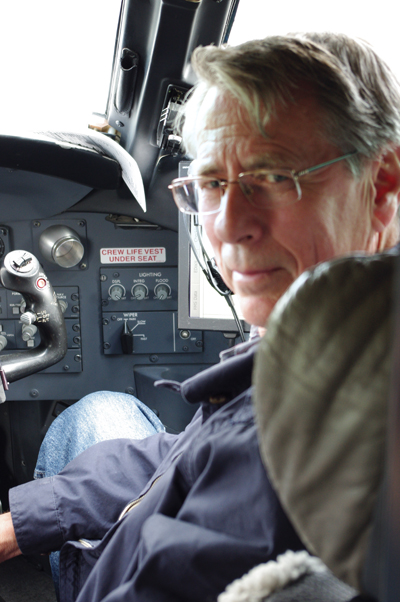
News
45º 42′: Changing course
Retiring with 25,000 hours of flying, Schmidt emphasized to his audience that flying is very much a people-oriented business.
September 27, 2010 By Peter Pigott
The Scene is the Shell AeroCentre, Ottawa International Airport on a sultry summer afternoon. Outside, a NAV CANADA RJ-200 “beats up” the runway. It is Greg Schmidt’s last flight as a pilot and the control tower has accorded him that privilege. At 64 years of age, he is retiring from NAV CANADA and flying.
 |
|
At the Shell AeroCentre, NAV CANADA employees, Schmidt’s wife, daughters and son, along with Algonquin College students, watch the CRJ taxi in. What, we all wonder, will run through his mind as he goes through the final checks and makes that last entry in his logbook? It is the inevitable, poignant moment every pilot faces. When asked about Schmidt, one of his colleagues described him thus: “Let me put it this way, he does a great Clint Eastwood impression.”
Schmidt enters the Centre to applause and is asked to say a few words to the audience, especially the students. He emphasizes that flying is very much a people-
oriented business and they should always cultivate contacts both within and outside the aviation world. “When flying an aircraft,” he says, “get used to someone always casting a critical eye over your shoulder. Remember that extreme disappointments are normally followed by successes.”
How did it all begin for him? “One day an aeronautical chart, circa 1956, fell to our driveway, apparently from one of the DC-3s flying the Calgary to Edmonton route overhead,” he recalls. The Harvard trainers that regularly buzzed the family acreage encouraged the interest in aviation. “One flew by so close I could clearly see the pilot wave,” he remembered. “I was hooked.”
While working as an Electronics Technician on the Canadian Marconi F-111 radar project in Montreal, Schmidt took his first flying lesson at Cartierville airport on June 30, 1968. But the pay wasn’t enough to continue flying so he left to work for Alberta Government Telephones in Lethbridge, Alta. This allowed him to complete his Private Pilot Licence at the Lethbridge Flying Club with Roy Price, a mentor he has never forgotten. A partnership in a Cessna 150 led to a Single Engine Commercial Licence, and to pay for his Multi-Engine/Instrument rating, Schmidt took to operating heavy equipment in the high Arctic. “Lady luck was with me there as I delayed my return to the Arctic by one week and the Panarctic Lockheed Electra that I was to be on crashed on October 30, 1974, at Rae Point, Mellville Island. Many people I had worked with all winter were lost on that flight.”
His first paying job as a pilot was on a Twin Comanche with Chinook Aviation in Calgary. Chinook was contracted to supply specially modified aircraft for seeding thunderstorms in a project called “Hailstop74.” The end of the hail season meant he was unemployed once more. “It was here I learned the importance of developing solid contacts within the aviation industry,” he says. “One of the Hailstop pilots convinced me to get an Instructor Rating with the Edmonton Flying Club. He said it keeps you current, you build time and you keep in touch with the industry in a major oil field centre. He was right.”
Schmidt did so and within two years, the hours accumulated and eventually got him a job flying Learjets for Brooker Wheaton Aviation Ltd. When the collapse of the Western oil industry put many pilots out of work, contacts rescued him again – this time in Transport Canada, allowing him to apply to the newly centralized Flight Inspection organization in Ottawa. He began on the Dash 8, then the Challenger 601 and in 2008, the RJ200.
Flight Inspection (FI) of navaids is a constantly challenging environment; the aircraft is not used as transportation, but as a measuring tool.
With 25,000 hours of flying, Schmidt has a multitude of stories. One that leaves a vivid picture in his mind was in a Learjet 24 at 45,000 feet, 50 miles north of Rae Point in mid winter. “We were between two to five miles from a meteorite entry left to right across our windscreen. The relative size of the meteorite in the windscreen was the same relative size as the full moon. It deflected slightly and broke into five pieces. It was so bright we were temporarily blinded. It remains the most spectacular event I’ve ever seen.”
When asked what he was going to do in retirement, he talked of his seven grandchildren. “Some have already expressed a keen interest in aircraft – it’s up to me to foster that.” Living under the flight path for runway 07 at Ottawa Airport, Schmidt says the numerous aircraft passing overhead remind him of who he is.
Peter Pigott is a Wings writer and columnist.